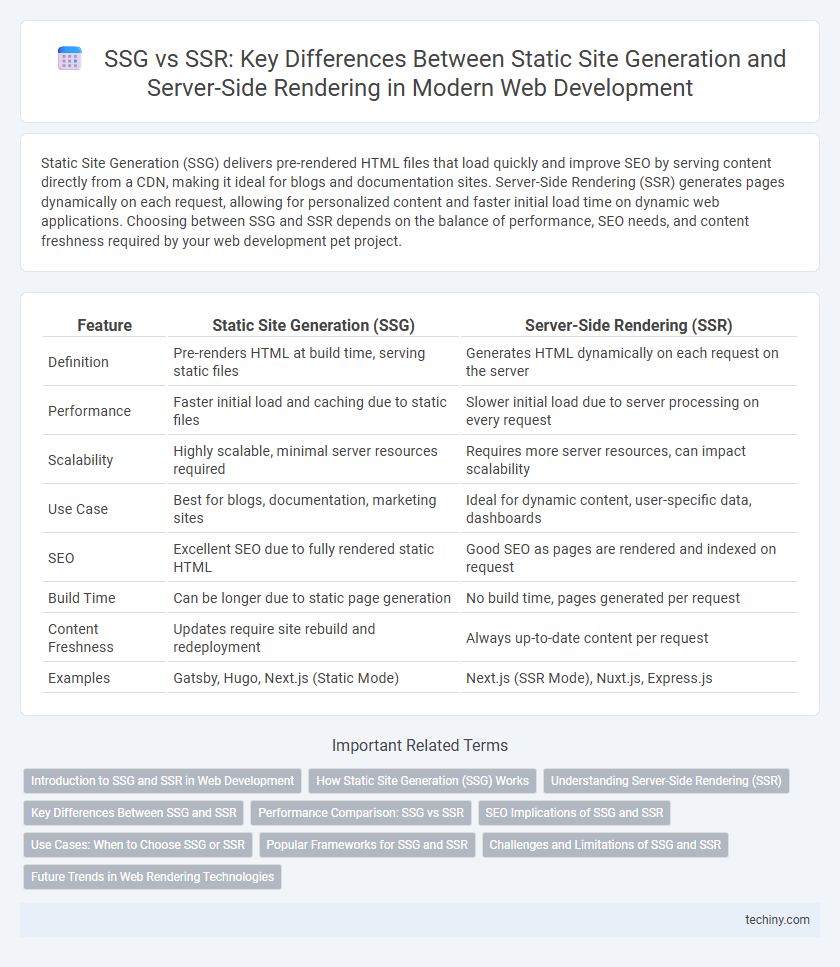Static Site Generation (SSG) delivers pre-rendered HTML files that load quickly and improve SEO by serving content directly from a CDN, making it ideal for blogs and documentation sites. Server-Side Rendering (SSR) generates pages dynamically on each request, allowing for personalized content and faster initial load time on dynamic web applications. Choosing between SSG and SSR depends on the balance of performance, SEO needs, and content freshness required by your web development pet project.
Table of Comparison
| Feature | Static Site Generation (SSG) | Server-Side Rendering (SSR) |
|---|---|---|
| Definition | Pre-renders HTML at build time, serving static files | Generates HTML dynamically on each request on the server |
| Performance | Faster initial load and caching due to static files | Slower initial load due to server processing on every request |
| Scalability | Highly scalable, minimal server resources required | Requires more server resources, can impact scalability |
| Use Case | Best for blogs, documentation, marketing sites | Ideal for dynamic content, user-specific data, dashboards |
| SEO | Excellent SEO due to fully rendered static HTML | Good SEO as pages are rendered and indexed on request |
| Build Time | Can be longer due to static page generation | No build time, pages generated per request |
| Content Freshness | Updates require site rebuild and redeployment | Always up-to-date content per request |
| Examples | Gatsby, Hugo, Next.js (Static Mode) | Next.js (SSR Mode), Nuxt.js, Express.js |
Introduction to SSG and SSR in Web Development
Static Site Generation (SSG) pre-builds web pages at compile time, delivering fast, cacheable content ideal for sites with infrequent updates. Server-Side Rendering (SSR) generates pages dynamically on each request, enabling real-time data display and improved SEO for frequently changing content. Both techniques optimize performance and user experience by balancing pre-rendering speed with dynamic content needs in modern web development.
How Static Site Generation (SSG) Works
Static Site Generation (SSG) pre-renders web pages at build time, converting source code into static HTML files that can be efficiently served to users. This method improves load speed and scalability by delivering ready-to-serve content without server computation on each request. Popular frameworks like Next.js and Gatsby utilize SSG to optimize performance and SEO through static pre-rendering of pages.
Understanding Server-Side Rendering (SSR)
Server-Side Rendering (SSR) dynamically generates web pages on the server for each user request, delivering fully rendered HTML to the client. This approach improves initial load times and enhances SEO by providing search engines with pre-rendered content. Frameworks like Next.js and Nuxt.js leverage SSR to balance performance and dynamic content delivery in modern web development.
Key Differences Between SSG and SSR
Static Site Generation (SSG) pre-builds HTML pages at build time, delivering fast load speeds and improved SEO by serving static files from a CDN, while Server-Side Rendering (SSR) generates HTML dynamically on each request, allowing for real-time content updates and personalized user experiences. SSG excels in scalability and performance for content-heavy sites with less frequent updates, whereas SSR is better suited for applications requiring up-to-date data and user-specific content. The choice between SSG and SSR depends on factors such as content freshness, server resources, and user interaction requirements in web development.
Performance Comparison: SSG vs SSR
Static Site Generation (SSG) delivers pre-rendered HTML pages at build time, enabling faster load times and reduced server response latency compared to Server-Side Rendering (SSR), which generates pages on each request. While SSR offers dynamic content capabilities and real-time data rendering, it often incurs higher CPU usage and slower initial page load due to server processing per request. For high-traffic sites prioritizing speed and scalability, SSG provides superior performance through CDN distribution and caching optimizations.
SEO Implications of SSG and SSR
Static Site Generation (SSG) delivers pre-rendered HTML pages, leading to faster load times and enhanced crawlability by search engines, which positively impacts SEO rankings. Server-Side Rendering (SSR) generates HTML on each request, ensuring dynamic content is indexed accurately but may introduce latency affecting user experience and SEO. Both approaches improve SEO compared to client-side rendering, with SSG favored for speed and SSR preferred for personalized, real-time content visibility.
Use Cases: When to Choose SSG or SSR
SSG is ideal for content-focused websites like blogs, portfolios, or marketing pages where fast load times and SEO are crucial since pages are pre-built at deploy time. SSR suits dynamic web applications, e-commerce sites, or dashboards requiring real-time data or personalized content, as pages are rendered on each request. Choosing between SSG and SSR depends on the need for static content delivery versus server-side data processing and user-specific rendering.
Popular Frameworks for SSG and SSR
Next.js and Gatsby are leading frameworks for Static Site Generation (SSG), offering fast performance and improved SEO by pre-rendering pages at build time. For Server-Side Rendering (SSR), frameworks like Next.js and Nuxt.js enable dynamic content rendering on the server for every request, ensuring real-time data updates. Both approaches are widely supported across React and Vue ecosystems, catering to different project requirements and user experience goals.
Challenges and Limitations of SSG and SSR
Static Site Generation (SSG) faces challenges with dynamic content updates and scalability when handling frequent data changes or user-specific customization, leading to potential delays in content refresh and increased build times. Server-Side Rendering (SSR) can suffer from higher server load and latency issues during peak traffic, impacting performance and user experience. Both approaches require trade-offs in SEO optimization, caching strategies, and infrastructure costs to balance speed, interactivity, and maintainability.
Future Trends in Web Rendering Technologies
Static Site Generation (SSG) and Server-Side Rendering (SSR) continue evolving with a focus on hybrid models that combine the speed of pre-rendered content with the dynamism of server-rendered pages. Emerging frameworks like Next.js and SvelteKit optimize incremental static regeneration and selective SSR to enhance performance and SEO simultaneously. Future trends emphasize edge computing integration and AI-driven rendering strategies, enabling personalized, low-latency web experiences across distributed networks.
SSG vs SSR (Static Site Generation vs Server-Side Rendering) Infographic

 techiny.com
techiny.com